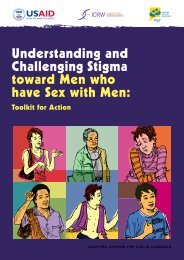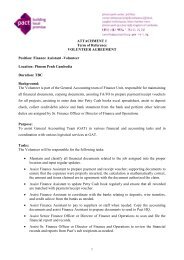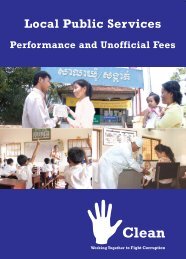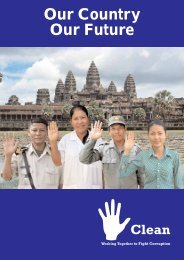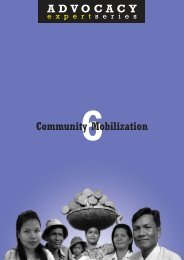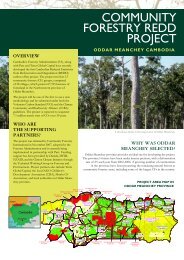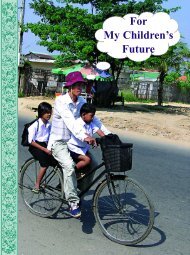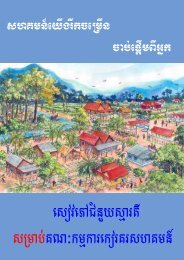Advocacy in Cambodia: Increasing Democratic ... - Pact Cambodia
Advocacy in Cambodia: Increasing Democratic ... - Pact Cambodia
Advocacy in Cambodia: Increasing Democratic ... - Pact Cambodia
Create successful ePaper yourself
Turn your PDF publications into a flip-book with our unique Google optimized e-Paper software.
the relocation site and not at the fire site. NGOs<br />
opposed this because people who lost their homes<br />
needed supplies and emergency shelter<br />
immediately at the fire site and adequate<br />
<strong>in</strong>frastructure had not yet been <strong>in</strong>stalled at the<br />
relocation site. After a second large fire ran<br />
through another slum, there was an absolute<br />
refusal of permission by the Municipality to donate<br />
emergency supplies to fire<br />
victims at the fire site.<br />
Despite the number of<br />
agencies work<strong>in</strong>g <strong>in</strong> this<br />
sector, NGOs were not able to<br />
mount a significant<br />
coord<strong>in</strong>ated response.<br />
Currently a new effort is<br />
underway to renew NGO<br />
coord<strong>in</strong>ation on advocacy<br />
issues regard<strong>in</strong>g the urban<br />
poor. (See page 82.)<br />
HIV/AIDS<br />
The 2001 NGO<br />
Statement to the Consultative Group Meet<strong>in</strong>g<br />
section on HIV/AIDS <strong>in</strong>dicates that <strong>in</strong> 2000<br />
approximately 169,000 people (2.8% of the<br />
population aged 25-49 years) are liv<strong>in</strong>g with HIV.<br />
The HIV/AIDS sector <strong>in</strong> <strong>Cambodia</strong> presents a<br />
good mix of HIV/AIDS specialized organizations<br />
and NGOs with HIV/AIDS components. The HIV/<br />
AIDS Coord<strong>in</strong>at<strong>in</strong>g Committee with 55 members<br />
offers a venue for agencies to network and obta<strong>in</strong><br />
general <strong>in</strong>formation about the sector. However,<br />
advocacy activities to date have focused ma<strong>in</strong>ly on<br />
public education and awareness rais<strong>in</strong>g.<br />
A few projects are emerg<strong>in</strong>g to address this<br />
issue, notably the <strong>Cambodia</strong>n Positive Network,<br />
which was created with support and technical<br />
assistance from KHANA, FHI, and the Policy<br />
Project to encourage people liv<strong>in</strong>g with AIDS to<br />
participate <strong>in</strong> policy dialogues. Other advocacy<br />
projects are work<strong>in</strong>g with government<br />
departments to review their HIV/AIDS policies<br />
and implement them. For many organizations,<br />
however, HIV/AIDS advocacy cont<strong>in</strong>ues to be an<br />
abstract concept and NGOs need to learn how to<br />
make the issue more relevant to themselves, their<br />
constituencies, and potential HIV/AIDS advocates<br />
com<strong>in</strong>g from the grow<strong>in</strong>g HIV positive population<br />
<strong>in</strong> <strong>Cambodia</strong>. (See page 88.)<br />
Children’s Rights<br />
Child Rights became an issue <strong>in</strong> <strong>Cambodia</strong><br />
when the government signed the UN Convention<br />
<strong>in</strong> 1992. S<strong>in</strong>ce then, civil society organizations have<br />
worked on child’s rights issues at a variety of levels.<br />
In 2001, the NGO Child Rights Committee<br />
The <strong>Cambodia</strong>n Positive<br />
Network was created with<br />
support and technical<br />
assistance from KHANA,<br />
FHI, and the Policy Project<br />
to encourage people liv<strong>in</strong>g<br />
with AIDS to participate <strong>in</strong><br />
policy dialogues.<br />
prepared a parallel report to the government’s<br />
report on progress made towards meet<strong>in</strong>g the<br />
criteria of the Convention. Members of the<br />
committee traveled to Geneva to present their<br />
f<strong>in</strong>d<strong>in</strong>gs and recommendations, many of which<br />
were <strong>in</strong>corporated <strong>in</strong>to the UN’s<br />
recommendations to the <strong>Cambodia</strong>n government.<br />
A number of NGOs are currently<br />
implement<strong>in</strong>g activities that<br />
aim to protect children from<br />
child labor. For example, <strong>in</strong><br />
order to mobilize community<br />
support for the issue, local<br />
NGO LICADHO tries to<br />
identify community leaders<br />
who have demonstrated<br />
concern for the problem<br />
before the NGO enters the<br />
community with a program<br />
designed to promote<br />
children’s rights. Us<strong>in</strong>g a<br />
series of workshops rather<br />
than a s<strong>in</strong>gle <strong>in</strong>tervention, the<br />
organization targets<br />
department officials, local authorities, parents,<br />
children, and concerned community members and<br />
establishes a committee with representatives from<br />
each group to meet on a regular basis. The strategy<br />
is beg<strong>in</strong>n<strong>in</strong>g to show success as the committees<br />
start to address cases of abuse com<strong>in</strong>g from their<br />
own <strong>in</strong>itiative. (See page 92.)<br />
Child labor at a brick factory <strong>in</strong> Kagn Chreach<br />
district, Prey Veng prov<strong>in</strong>ce, February 2002.<br />
The child labor problem <strong>in</strong> <strong>Cambodia</strong> began<br />
draw<strong>in</strong>g national attention <strong>in</strong> the mid-1990s.<br />
Increas<strong>in</strong>g <strong>Democratic</strong> Space<br />
15




